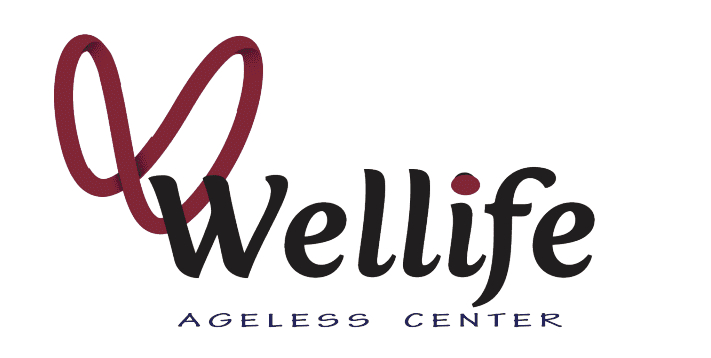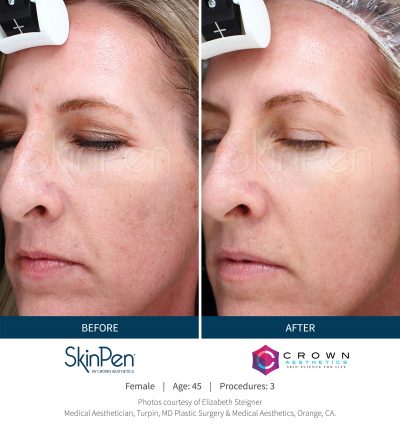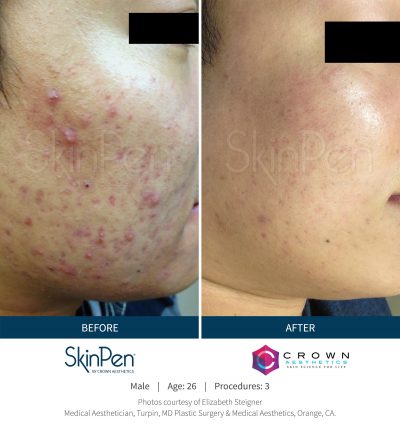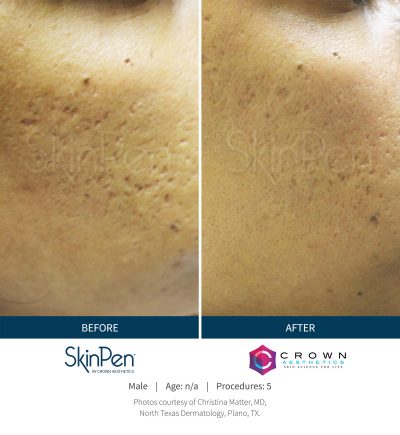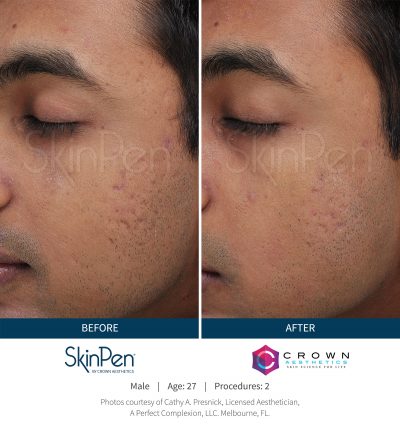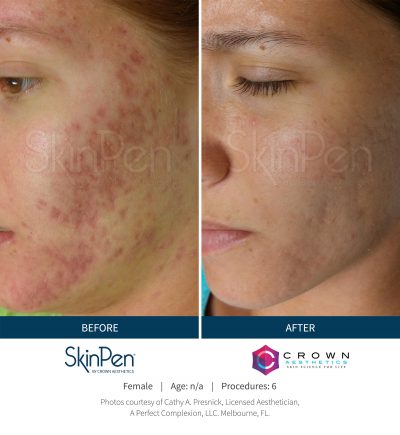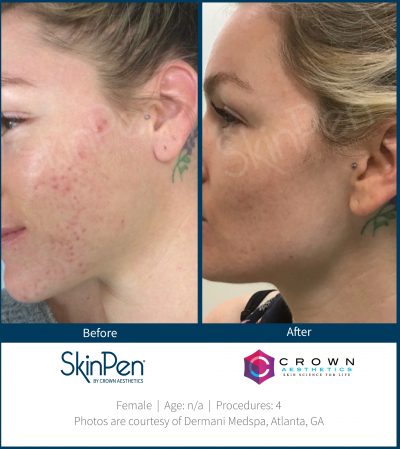


Schedule a Free Consultation
By submitting this form you agree to be contacted via text/phone/email.
Microneedling Sandy Springs, GA
Microneedling (aka collagen-induction therapy) is a non-surgical treatment that penetrates your skin’s surface with fine needles to improve its appearance. This popular procedure can help smooth lines and wrinkles, even skin tone (including stubborn melasma), minimize large pores, firm skin, and fade stretch marks and scars, including acne scars.
Deliberately inserting tiny needles into your skin may sound a little medieval, but most skin rejuvenation treatments (including lasers and chemical peels) trigger a similar kind of wound-healing response, to kick-start a regeneration process at the cellular level.
- The treatment is quick (about 15 minutes), comfortable when paired with a topical numbing cream, and relatively cost-effective.
- The treatment can be customized to treat localized problem areas, such as acne scars, dark under-eye circles, crow’s feet, and neck or chest lines.
- Recovery time is usually just a few days, depending on your treatment intensity.
- Microneedling doesn’t involve the delivery of heat, so it’s safe to use on all skin tones without the risk of pigmentation issues that can accompany laser resurfacing and light procedures.
- Though it’s mostly used on the face, neck, chest, and hands, microneedling can be done all over the body.


Schedule a FREE Consultation
By submitting this form you agree to be contacted via text/phone/email.
RF Microneedling
Radiofrequency microneedling (RF microneedling) is a non-invasive skin rejuvenation treatment that enhances the collagen-boosting effects of microneedling with the heat of radiofrequency energy. It improves skin texture and tone, pore size, fine lines, wrinkles, laxity, acne scars, and stretch marks.
RF microneedling works by creating controlled microdamage that provokes a natural wound-healing response, which kick-starts the biological processes that create new collagen and elastin. Aging and environmental damage (particularly sun damage) break down these structural proteins, while the rate of replacement slows over time. RF microneedling slows and even temporarily reverses this process, helping skin look and act younger.
- You reap the collagen production-boosting benefits of both microneedling and radiofrequency energy, all in one treatment.
- Microneedling with radiofrequency has minimal downtime—you can go about normal activities the day after treatment.
- This anti-aging treatment is considered suitable for all skin types and tones, with little risk of burning, scarring, or pigmentation issues when it’s performed properly.
- The RF microneedling handpiece can be used on any area of the body. The most common treatment areas include the face, neck, and chest, but it can also be used on the abdomen, knees, and thighs.
- Beyond the benefits of skin tightening and smoothing, the procedure can help fade scars and stretch marks that result from damage to the deeper, thicker layer of skin known as the dermis.
SkinPen Microneedling
- Phase I: Inflammation. Piercing the skin triggers your immune system to cleanse the wound, remove debris, increase blood flow and begin to create new tissue.
- Phase II: Proliferation. The wound is rebuilt with new granulation cells, which are part of the extracellular matrix. Additionally, a new network of blood vessels develops.
- Phase III: Remodeling. The wound is replaced with new dermal tissues and blood vessels.
Best of all, SkinPen works. Ninety percent of subjects in the clinical trial would recommend the procedure to family and friends.
Benefits of SkinPen
- Little Downtime: It is a perfect treatment for patients with a busy schedule.
- Natural Recovery: SkinPen’s mechanical process is versatile and usable year-round.
- Safe for all Skin Types: Clinically proven effective on all skin types, Fitzpatrick 1 – 6.
- Safe and Sound: The First FDA-cleared microneedling device on the market
- Comfortable: A light numbing cream may be used to minimize discomfort
SkinPen Microneedling
Before and After*
Learn more about how microneedling works. With as few as three non-invasive and affordable treatments spaced 30 days apart, you can improve your appearance for six months after your last treatment!
Secret™ RF
SKIN REVITALIZATION AND RESURFACING
Secret RF offers dermal remodeling from the inside out. This tailored approach to skin revitalization delivers bipolar Radio Frequency (RF) energy with either semi-insulated or non-insulated microneedles to stimulate and remodel collagen to address the common signs of aging including fine lines, wrinkles, scars, and photodamage on all skin types.
Applications
- Fine lines
- wrinkles
- photoaging
- scarring
- acne scars
- striae
Secret™ RF Microneedling
Before and After*



Frequently Asked Questions
Adults who are in good health (free from any infections, a fever, or a rash) and looking to help smooth fine lines and wrinkles, boost collagen production, or combat scars from acne or injuries are good candidates for microneedling.
There are relatively few risks with the treatment, but it isn’t recommended for women who are pregnant or nursing. It’s also not recommended for anyone with active skin conditions, like eczema or rosacea.
Additionally, if you have lupus or vitiligo, there can be unwanted side effects or lesions (called the Koebner phenomenon).
Microneedling may trigger cold sores. Tell your doctor if you’re prone to cold sores so you can start taking an antiviral medication a few days prior to your treatment.
By creating microscopic punctures in the skin, microneedling creates thousands of tiny injuries. This triggers a healing response that releases a cascade of growth factors, which in turn boosts production of the body’s own collagen (the protein fibers that keep skin smooth and supple).
It’s a form of fractional treatment, which means only a fraction of the skin’s surface is affected. This means that recovery time is relatively short.
Microneedling also allows ingredients to penetrate dramatically better and work more effectively, by creating channels for topical products to be absorbed.
Microneedling can be painful, so about an hour prior to the procedure, a topical anesthetic cream will be applied to the treatment area.
Once you’re numb, your skin is cleansed and dried. Then, based on what issue you’re trying to treat, an active serum is applied—for instance, salicylic acid for acne or vitamin C for pigmentation.
The original microneedling device, a dermal roller that would be rolled over the skin, has mostly been replaced in doctor’s offices by automated devices that contain single-use, sterile needle cartridges with a varying number of needles—anywhere from a dozen to more than 160, depending on the device.
Microneedling techniques vary; most devices have an adjustable needle head that customizes the depth of the needle pricks.
Your provider will probably recommend starting with a series of three to five treatments, spaced about a month apart.
Post-treatment, your skin will look like it has a bad sunburn.
You may see redness, swelling, crusting, tightness, and sensitivity for about three days during the healing process, though it can last for up to 12 days if your skin was treated aggressively.
If your skin is fair, you’ll stay pink for a day or two longer than people with olive or brown skin.
You can wash your face in 8 hours (or earlier if your doctor recommends it). With makeup, you can usually go to work the next day. Your provider may ask that you not use any makeup on the day of your treatment, but since it’s important to protect skin from the sun exposure, mineral powder sunscreen is usually permitted.
RealSelf members give microneedling an 85% Worth It Rating, and the science behind the treatment, which dates back to the early 1900s, is also stacking up. In a 2018 study on patients ages 35 to 75, researchers reported a noticeable improvement in lines and wrinkles, skin laxity, and skin texture three months after the first of four monthly microneedling treatments—and improvements continued for two more months.
The boost in skin tightening, researchers noted, was largely due to the conversion of collagen III, the type found in older skin, to collagen I, the type found in younger skin—a process that can take as long as a year to complete.
Microneedling is also effective for scars, though the level of improvement depends on the type of scar. In a 2015 study on pitted acne scars, biweekly treatments produced a good to very good response in rolling and boxcar scars, which are shallow, while icepick and deeper scars had a moderate to poor response.
Studies also show that early and late stretch marks can be improved by microneedling, however, doctors on RealSelf stress that consistent and long-term treatment—often six or seven sessions—is needed to make them less noticeable.
In the study mentioned above, side effects (mainly redness) were minor and easily managed compared to other invasive technologies, such as laser ablation and radiofrequency energy treatments.
Yes, RF microneedling produces more dramatic results than traditional microneedling or radiofrequency treatments alone, as the combination of the two technologies boosts their effectiveness.
Microneedles allow precise delivery of radiofrequency energy into the dermal layer of skin, where collagen-producing cells reside, while the radiofrequency energy increases the level of controlled damage the microneedles inflict.
A RF microneedling treatment session typically takes 30–45 minutes.
At each treatment session, your provider will first cleanse your skin and apply a topical numbing cream, to help mitigate pain. Once you’re sufficiently numb, they’ll begin pressing the handheld device into your skin, stamping it across the entire face or other targeted treatment area.
When the microneedles puncture your skin, they emit the RF energy as heat, delivering it directly into the dermis. You may feel a warm, prickling sensation, but it shouldn’t be painful because your skin will be numb.
After the treatment is complete, your provider may apply a calming mask or balm to your skin before sending you on your way.
Most patients have little to no downtime. Immediately after your treatment, you might have a little pinpoint bleeding, flushing, and swelling—all part of the expected inflammatory response to the micro-injuries inflicted on your skin. These side effects should resolve in 24–48 hours.
As you recover, you can encourage healthy healing with gentle skincare.
A physical sunscreen (featuring titanium dioxide or zinc oxide) with an SPF of at least 30 will help protect your skin, with less potential for irritation than with a chemical sunscreen that may enter the micro channels left by the needles.
While you can wear makeup the day after treatment, keep those little puncture marks in mind. Your skin may be more sensitive, and skincare products will penetrate more deeply than usual. Talk with your provider about whether you’ll need to lay off skin-care products with potent active ingredients (e.g., retinoids, vitamin C serums, exfoliating acids) for a few days, or if there may be some advantage to using certain ingredients while they can be more easily absorbed.
You may notice your complexion looking brighter and smoother within the first two weeks of treatment.
However, it’ll be up to six months before you see all the structural benefits, including firmer skin. It takes time for your body to produce the new collagen and elastin.
Your results will continue to improve with each treatment, reaching maximum improvement a few months after your final treatment session.
RF microneedling is widely considered to be a safe treatment, with mild, temporary side effects. Bleeding, scabbing, swelling, or flushing usually subside within a few days, if they occur at all. Possible pinprick marks from the needles should fade on their own within two weeks.
When done right, this treatment should cause only controlled microdamage—not real, lasting damage—to your skin.
However, RealSelf members who say it’s “Not Worth It” frequently report long-term textural issues, visible pinpricks, or grid marks following their treatment.
An experienced provider should know precisely how much of an injury to create, without inducing those adverse effects.


Schedule a Free Consultation
By submitting this form you agree to be contacted via text/phone/email.
DISCLAIMER
*Results may vary. We are reputable for complete customer satisfaction for completed treatments. Before and after images reflect real results from real patients, although individual results may vary. No treatment is promised to provide permanent results. A guarantee is neither provided nor implied. Statements estimating treatment duration and the number of treatments required are based on the typical experience of our patients, however, individual experiences may vary.
